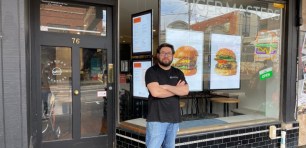
Small business closes doors during COVID-19. Source: Unsplash/Anastasiia Chepinska.
The cost of the lockdown in Sydney and Melbourne has been estimated as high as $7 billion. That’s a huge sum. But the effect is not spread evenly. By this stage of the pandemic, weary small and medium business owners know the majority of the downside falls on them.
We could start this story with a quote from the august financial minds at the Reserve Bank of Australia, but instead lets start with a social media post from the owner of struggling family-friendly pub The Victoria Hotel, in Melbourne.
“We tried… We honestly tried…” wrote hotel owner Annette Murdaca-Soto on the pub’s facebook page last Friday.
“Unfortunately businesses are not like a light switch, turning off and then on again.
“… The level of anxiety that this has caused for us as business owners and our staff — just needlessly, we now just feel let down. We have come back after each lockdown with the ever hopeful optimism that as Melburnians we stand together and we will get through this, however this time we have nothing left to give, mentally and financially. With a heavy heart we will permanently close The Victoria Hotel Yarraville.”
The pain is palpable. And this is just one business, a speck in the statistics. What’s more is in Melbourne, the chances are the lockdown could be over in under a month. Sydney is looking at more than that.
Lockdowns are relentlessly hard on businesses, especially in the hospitality sector, where so many small business reside. Even moreso now that the government’s signature support policies have dried up. No more JobKeeper, no more cashflow boost. That leaves a gaping hole and despite the federal disaster payment, the NSW JobSaver program and various other supports the situation for small and medium enterprises could get dire if the lockdowns stretch on.
If you were designing a lockdown to hurt small business, you’d put it in Sydney and Melbourne. NSW and Victoria are home to 48% of Australia’s population, but those people include a disproportionate number of business owners. Over 60% of Australian businesses are in NSW and Victoria.
Big businesses have had, in many cases, very good pandemics. Mining companies have felt barely a blip. Major supermarkets have done extremely well. Big banks are lending more than ever. JB Hi-Fi and Officeworks are loving the fact we don’t go to the office or out at night so much any more. It is small business where the hurt is found.
“While economic conditions are improving, it has been a particularly tough year for small businesses. The pandemic caused the largest economic downturn in Australia since the 1930s. Businesses in all industries and of all sizes have been significantly affected, although the experience has been quite uneven,” RBA Assistant Governor Chris Kent said in a speech in March.
“In particular, small businesses have generally been hit harder than larger businesses.”
A great example of this is the retail sector. Amid the lockdowns of 2020, large retailers grew their sales. The yellow line spiked. But small businesses in the retail space suffered huge falls in revenue. And as the economic good times in 2020 have emerged, large retailers have continued to do better than their smaller brethren.

Small business employs around 5 million Australians, so when small business suffers, Australia suffers.
In 2020, headlines proclaimed that large business would emerge triumphant from the pandemic at the expense of small business. “The End of Small Business” trumpeted the Washington Post. It hasn’t got quite that bad, but lockdowns hit small business harder than large. One reason is access to finance. While large businesses are issuing shares and bonds, small to medium businesses are generally stuck with the banks. And banks lend far less to small businesses as the next graph shows.

Where they do lend, they demand security. Small business owners are regularly on the hook for their house. Despite that, small and medium enterprises still pay more for finance, with interest rates around 150 basis points (i.e. 1.5 percentage points) higher than large business.
The government’s term funding facility is designed to help. But at this point what will help small business most is success on the health front. The best lockdown is a short one. Let’s hope NSW and Victoria can get the most recent delta waves under control, and fast.
Handpicked for you

Victorian businesses are still waiting for payments from the previous two lockdowns, let alone lockdown 5.0



COMMENTS
SmartCompany is committed to hosting lively discussions. Help us keep the conversation useful, interesting and welcoming. We aim to publish comments quickly in the interest of promoting robust conversation, but we’re a small team and we deploy filters to protect against legal risk. Occasionally your comment may be held up while it is being reviewed, but we’re working as fast as we can to keep the conversation rolling.
The SmartCompany comment section is members-only content. Please subscribe to leave a comment.
The SmartCompany comment section is members-only content. Please login to leave a comment.